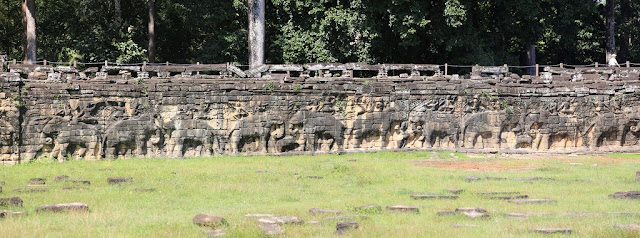Phnom Bakheng Temple is at Angkor Area, Cambodia, is a Hindu and Buddhist
temple in the form of a temple mountain. Dedicated to Shiva, it was built at
the end of the 9th century, during the reign of King Yasovarman (889-910).
Located atop a hill, it is nowadays a popular tourist spot for sunset views of
the much bigger temple Angkor Wat, Every day have a lot of tourism claim up to watching Sunset at the temple on top the Bakheng Mountain, which lies amid the jungle about 1.5 km to
the southeast. The large number of visitors makes Phnom Bakheng one of the most
threatened monuments of Angkor. Since 2004, World Monuments Fund has been
working to conserve the temple in partnership with APSARA.

Constructed more than two centuries before Angkor Wat, Phnom Bakheng
was in its day the principal temple of the Angkor region, historians believes.
It was the architectural centerpiece of a new capital, Yasodharapura that
Yasovarman built when he moved the court from the capital Hariharalaya in the
Roluos area located to the southeast.
An inscription dated 1052 AD and found at the Sdok Kak Thom temple in
present-day Thailand states in Sanskrit: "When Sri Yasovardhana became
king under the name of Yasovarman, the able Vamasiva continued as his guru. By
the king's order, he set up a linga on Sri Yasodharagiri, a mountain equal in
beauty to the king of mountains. Scholars believe that this passage refers to
the consecration of the Phnom Bakheng temple approximately a century and a half
earlier.
Surrounding the mount and temple, labor teams built an outer moat.
Avenues radiated out in the four cardinal directions from the mount. A causeway
ran in a northwest-southeast orientation from the old capital area to the east
section of the new capital's outer moat and then, turning to an east-west
orientation, connected directly to the east entrance of the temple.
Phnom Bakheng is a symbolic representation of Mount Meru, home of the
Hindu gods, a status emphasized by the temple’s location atop a steep hill 65 m
above the surrounding plain. The temple is built in a pyramid form of seven
levels, representing the seven heavens. At the top level, five sandstone
sanctuaries, in various states of repair, stand in a quincunx pattern one in
the center and one at each corner of the level’s square. Originally, 108 small
towers were arrayed around the temple at ground level and on various of its
tiers; most of them have collapsed.
Phnom Bakheng is one of three hilltop temples in the Angkor region that
are attributed to Yasovarman's reign. The other two are Phnom Krom to the south
near the Tonle Sap Lake, and Phnom Bok, northeast of the East Barayreservoir.
Following Angkor's rediscovery by the outside world in the mid-19th
century, decades passed before archeologists grasped Phnom Bakheng's historical
significance. For many years, scholars' consensus view was that the Bayon, the
temple located at the center of Angkor Thom city, was the edifice to which the
Sdok Kak Thom inscription referred. Later work identified the Bayon as a
Buddhist site, built almost three centuries later than originally thought, in
the late 12th century, and Phnom Bakheng as King Yasovarman's state temple.
Source: wikipedia.org






